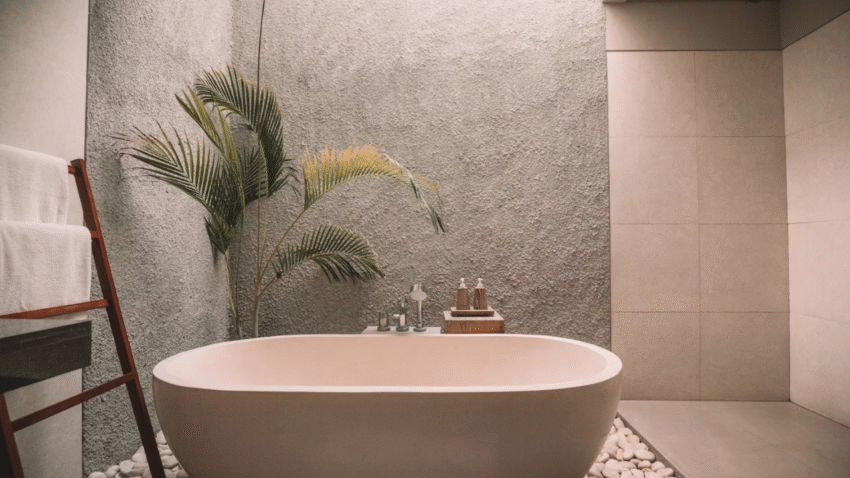Introduction
Worried about frozen or sweating pipes in your bathroom? Knowing how to insulate bathroom pipes can save you from expensive water damage, burst pipe repairs, and higher energy bills. Whether it’s winter cold or summer humidity, pipe insulation is a smart, affordable upgrade for any bathroom.
This guide will show you exactly how to identify vulnerable pipes, choose the right insulation, and install it yourself—even if you’re a beginner.
Why Insulating Bathroom Pipes Matters
Bathroom pipes are often located in cold or poorly ventilated spaces, such as exterior walls, under vanities, or inside crawl spaces. Left unprotected, these pipes can:
- Freeze and burst in winter temperatures
- Sweat and drip due to humidity in warm months
- Lose heat, making hot water take longer to arrive at the tap
- Raise energy costs and cause condensation-related mold growth
Insulating bathroom pipes improves efficiency, safety, and comfort—especially in climates with temperature swings or high humidity.
Step-by-Step Guide to Insulating Bathroom Pipes
1. Locate the Pipes That Need Insulating
Start by identifying the bathroom pipes you want to insulate. Focus on:
- Exposed hot and cold water pipes under sinks, behind toilets, and near bathtubs
- Pipes inside crawlspaces, basements, or exterior walls
- Pipes that have previously frozen or frequently drip with condensation
Tip: Use a flashlight to check under the vanity, in cabinets, or behind access panels.
2. Choose the Right Type of Insulation
There are several types of pipe insulation, each suited for different needs:
- Foam Pipe Tubing (Polyethylene or Rubber): Easy to install, affordable, and effective for hot and cold pipes. Great for DIY projects.
- Fiberglass Pipe Wrap: Best for high-temperature pipes or extreme cold. Comes with or without a vapor barrier.
- Reflective Foil Wrap: Ideal for tight spaces or around oddly shaped bends. Helps with heat retention.
Bonus: For pipes prone to freezing, consider pipe heating cables underneath insulation for extra protection.
3. Measure and Cut Insulation
Use a measuring tape to record the length of each pipe section you’ll be insulating. Buy insulation in pre-cut lengths or rolls and cut it to size using scissors or a utility knife.
Make sure to:
- Cut insulation long enough to cover the full pipe
- Create clean cuts to ensure tight joints and better sealing
Pro Tip: Mark the measurements on the insulation with a marker to avoid mistakes.
4. Clean the Pipe Surface
Before applying insulation, wipe down the pipes with a damp cloth to remove dust, oil, or moisture. A clean surface helps the insulation stick better and ensures no trapped moisture inside the wrap.
5. Install the Insulation
For Foam Pipe Insulation:
- Open the pre-slit foam sleeve along the seam.
- Snap the foam over the pipe, ensuring it wraps around fully.
- Secure the seam with adhesive tape, zip ties, or built-in peel-and-stick adhesive.
For Fiberglass Wrap:
- Wrap the insulation around the pipe, overlapping each turn by about ½ inch.
- Seal with foil tape or plastic ties.
- Cover with a vapor barrier wrap, if needed, especially in humid environments.
Around Elbows and Joints:
Use pre-molded elbow pieces, or cut the foam into mitered angles to fit around corners. Seal gaps with tape to prevent air leaks or moisture intrusion.
6. Secure and Seal the Insulation
Use duct tape, zip ties, or pipe insulation tape to secure each piece in place. Focus on:
- End joints where two pieces meet
- Around valves, elbows, and tees
- Any slits or seams in the insulation
A tight seal boosts thermal protection and helps prevent pipe sweating or freezing.
7. Inspect and Maintain Regularly
Check the insulation at least once a year—ideally before winter:
- Look for cracks, sagging, or moisture buildup
- Replace worn or moldy insulation immediately
- Make sure it’s still securely fastened and covers the full pipe
Common Mistakes to Avoid
Mistake 1: Leaving Gaps at Joints or Corners
Solution: Always seal overlaps, seams, and corners with tape or extra insulation for a continuous barrier.
Mistake 2: Using the Wrong Insulation Type
Solution: Choose foam tubing for indoor bathrooms, fiberglass for extreme cold, and heat cables if pipes are near freezing conditions.
Mistake 3: Insulating Only Hot Pipes
Solution: Cold water pipes also need insulation to prevent condensation and reduce moisture buildup.
Mistake 4: Ignoring Pipe Valves and Fixtures
Solution: Insulate valves, joints, and fittings too—they’re just as vulnerable as straight pipe sections.
Mistake 5: Installing Wet or Damp Insulation
Solution: Always dry the pipe before applying insulation to avoid mold or rot inside the wrap.
Extra Tips & Bathroom Hacks
- Use color-coded foam insulation (red for hot, blue for cold) to easily identify pipes later.
- Combine with wall insulation if pipes are located in exterior walls or behind drywall.
- Consider installing smart leak detectors near the base of toilets and vanities to catch problems early.
- Want more protection? Check out our guide on how to prevent bathroom mold and mildew.
Conclusion
Insulating bathroom pipes is a quick, affordable, and effective way to protect your home from water damage, improve energy efficiency, and ensure your bathroom functions smoothly year-round. Whether you live in a cold climate or just want to reduce condensation, this simple upgrade makes a big difference.
Don’t wait for a frozen pipe or water-stained cabinet—take action today and give your bathroom the protection it deserves.
Bookmark this guide so you can keep your bathroom warm, dry, and efficient all year long.
